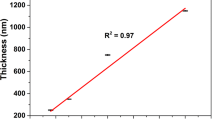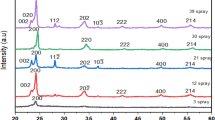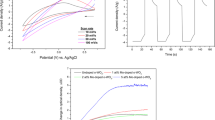Abstract
WO3 thin films were prepared on indium-tin oxide (ITO) glass substrates at different substrate temperature by radio frequency magnetron sputtering. Then the films were soaked in five organic solvents of acetone, ethanol, cyclohexane, acetonitrile and ethyl acetate for 48 h, respectively. The changes in the microstructure, surface morphology and electrochromic (EC) properties of WO3 thin films before and after the immersion treatment were systematically studied. It was found that after soaking in ethanol, the optical modulation of amorphous WO3 thin films deposited at room temperature increased from 50 to 85%, showing excellent EC performance. Moreover, the immersion treatment in ethanol is also helpful for improving the EC properties of amorphous WO3 thin films prepared at elevated substrate temperature. However, after immersion in the other organic solvents, the optical modulation of WO3 thin films increased less (for acetone: 77%) or even decreased significantly (for cyclohexane, acetonitrile and ethyl acetate: 31%, 30% and 35%, respectively). In addition, the immersion treatment in ethanol cannot improve the optical modulation of crystalline WO3 thin films prepared at 600 °C, which dropped from 58 to 40%. The authors believe that this is mainly related to the different dredging effects of various organic solvents on the transport channels of Li-ions and electrons in WO3 thin films. Therefore, this work provides a new approach for the optimization of EC performance of amorphous WO3 thin films.
Graphical Abstract






Similar content being viewed by others
References
Deb, S.K.: A novel electrophotographic system[J]. Appl. Opt. 8(101), 192–195 (1969)
Niklasson, G.A., Granqvist, C.G.: Electrochromics for smart windows: Thin films of tungsten oxide and nickel oxide, and devices based on these[J]. J. Mater. Chem. 17(2), 127–156 (2007)
Deb, S.K.: Opportunities and challenges in science and technology of WO3 for electrochromic and related applications[J]. Sol. Energy Mater. Sol. Cells. 92(2), 245–258 (2008)
Granqvist, C.G.: Electrochromics for smart windows: Oxide-based thin films and devices[J]. Thin solid films. 564, 1–38 (2014)
Huang, Z.F., Song, J., Pan, L., et al.: Tungsten oxides for photocatalysis, electrochemistry, and phototherapy[J]. Adv. Mater. 27(36), 5309–5327 (2015)
Bange, K.: Colouration of tungsten oxide films: A model for optically active coatings[J]. Sol. Energy Mater. Sol. Cells. 58(1), 1 (1999)
Lee, S.H., Cheong, H.M., Tracy, C.E., et al.: Electrochromic coloration efficiency of a-WO3 – y thin films as a function of oxygen deficiency[J]. Appl. Phys. Lett. 75(11), 1541–1543 (1999)
Zhang, Y., Liang, X., Jiang, T., et al.: Amorphous/crystalline WO3 dual phase laminated films: Fabrication, characterization and evaluation of their electrochromic performance for smart window applications[J]. Sol. Energy Mater. Sol. Cells. 244, 111820 (2022)
Granqvist, C.G.: Oxide electrochromics: An introduction to devices and materials[J]. Sol. Energy Mater. Sol. Cells. 99, 1–13 (2012)
Bechinger, C., Ferrere, S., Zaban, A., et al.: Photoelectrochromic windows and displays[J]. Nature. 383(6601), 608–610 (1996)
Runnerstrom, E.L., Llordés, A., Lounis, S.D., et al.: Nanostructured electrochromic smart windows: Traditional materials and NIR-selective plasmonic nanocrystals[J]. Chem. Commun. 50(73), 10555–10572 (2014)
Avendaño, E., Berggren, L., Niklasson, G.A., et al.: Electrochromic materials and devices: Brief survey and new data on optical absorption in tungsten oxide and nickel oxide films[J]. Thin solid films. 496(1), 30–36 (2006)
Lynam, N.R.: Electrochromic automotive day/night mirrors[J]. SAE Trans., : 891–899. (1987)
Lee, S.H., Cheong, H.M., Zhang, J.G., et al.: Electrochromic mechanism in a-WO3 – y thin films[J]. Appl. Phys. Lett. 74(2), 242–244 (1999)
Garcia-Belmonte, G., Bueno, P.R., Fabregat-Santiago, F., et al.: Relaxation processes in the coloration of amorphous WO3 thin films studied by combined impedance and electro-optical measurements[J]. J. Appl. Phys. 96(1), 853–859 (2004)
Shi, Y., Sun, M., Zhang, Y., et al.: Rational design of oxygen deficiency-controlled tungsten oxide electrochromic films with an exceptional memory effect[J]. ACS Appl. Mater. Interfaces. 12(29), 32658–32665 (2020)
Wang, Z., Su, J., Qi, H., et al.: Porous nanocrystalline WO3 thin films: Fabrication, electrical and optical properties[J]. Surf. Innovations. 9(4), 214–221 (2020)
Yang, T., Lin, Z., Wong, M.: Structures and electrochromic properties of tungsten oxide films prepared by magnetron sputtering[J]. Appl. Surf. Sci. 252(5), 2029–2037 (2005)
Akl, A.A., Kamal, H., Abdel-Hady, K.: Characterization of tungsten oxide films of different crystallinity prepared by RF sputtering[J]. Phys. B: Condens. Matter. 325, 65–75 (2003)
Xue, J., Zhu, Y., Jiang, M., et al.: Electrochromic WO3 thin films prepared by combining ion-beam sputtering deposition with post-annealing[J]. Mater. Lett. 149, 127–129 (2015)
Madhuri, K.V., Babu, M.B.: Studies on electron beam evaporated WO3 thin films[J]. Materials Today: Proceedings, 3(1): 84–89. (2016)
Su, X., Li, Y., Jian, J., et al.: Situ etching WO3 nanoplates: Hydrothermal synthesis, photoluminescence and gas sensor properties[J]. Mater. Res. Bull. 45(12), 1960–1963 (2010)
Yu, Z., Jia, X., Du, J., et al.: Electrochromic WO3 films prepared by a new electrodeposition method[J]. Sol. Energy Mater. Sol. Cells. 64(1), 55–63 (2000)
Zhao, Y., Zhang, X., Chen, X., et al.: Preparation of WO3 films with controllable crystallinity for improved near-infrared electrochromic performances[J]. ACS Sustain. Chem. Eng. 8(31), 11658–11666 (2020)
Lee, S., Lee, Y., Kwak, D., et al.: Improved pseudocapacitive performance of well-defined WO3 – x nanoplates[J]. Ceram. Int. 41(3), 4989–4995 (2015)
Wang, X.G., Jang, Y.S., Yang, N.H., et al.: XPS and XRD study of the electrochromic mechanism of WOx films[J]. Surf. Coat. Technol. 99(1–2), 82–86 (1998)
Barreca, D., Carta, G., Gasparotto, A., et al.: A study of nanophase tungsten oxides thin films by XPS[J]. Surf. Sci. Spectra. 8(4), 258–267 (2001)
Bathe, S.R., Patil, P.S.: Titanium doping effects in electrochromic pulsed spray pyrolysed WO3 thin films[J]. Solid State Ionics. 179(9–10), 314–323 (2008)
Su, J., Zhang, J., Liu, Y., et al.: Parameter-dependent oxidation of physically sputtered Cu and the related fabrication of Cu-based semiconductor films with metallic resistivity[J]. Sci. China Mater. 59(2), 144–150 (2016)
Ma, J., Wang, Z., Qi, H., et al.: Fabrication of novel pyramid-textured and nanostructured Cu2O/Si heterojunctions[J]. Surf. Innovations. 9(4), 199–206 (2021)
Zeng, X., Ma, J., Su, J., et al.: Fabrication of hand-like CuO nanostructured films by free oxidation of Cu2O nanoporous films in alkaline solution[J]. Mater. Res. Express. 4, 045009 (2017)
Su, J., Wang, Z., Ma, J., et al.: Selective bias deposition of CuO thin film on unpolished Si wafer[J]. Mater. Res. Express. 7, 026402 (2020)
Zhu, Y., Ma, J., Zhou, L., et al.: Cu2O porous nanostructured films fabricated by positive bias sputtering deposition[J]. Nanotechnology. 30, 095702 (2019)
Zhu, Y., Ma, J., Su, J., et al.: Nanoinstabilities of Cu2O porous nanostructured films as driven by nanocurvature effect and thermal activation effect[J]. Nanotechnology. 30, 335711 (2019)
Xu, S., Zhou, C.H., Yang, Y., et al.: Effects of ethanol on optimizing porous films of dye-sensitized solar cells[J]. Energy Fuels. 25(3), 1168–1172 (2011)
Zhang, B., Xu, G., Liu, S., et al.: Electrochromic TiO2 films by a facile solvothermal process: Effect of ethanol content on growth and performance[J]. Opt. Mater. 122, 111744 (2021)
Zhu, X., Qi, H., Chen, J., et al.: Effects of deposition parameters on RF-sputtered WO3 thin films[J]. Surf. Innovations. (2022). https://doi.org/10.1680/jsuin.22.01031
Acknowledgements
This work was financially supported by Natural Science Foundation of Jiangsu Province (BK20191453) and Research and Innovation Program for Graduate Students of Jiangsu Province (KYCX21_2819 and KYCX21_2825).
Author information
Authors and Affiliations
Corresponding author
Ethics declarations
Conflict of Interests
The authors declare that they have no known competing financial interests or personal relationships that could have appeared to influence the work reported in this paper.
Additional information
Publisher’s Note
Springer Nature remains neutral with regard to jurisdictional claims in published maps and institutional affiliations.
Rights and permissions
Springer Nature or its licensor (e.g. a society or other partner) holds exclusive rights to this article under a publishing agreement with the author(s) or other rightsholder(s); author self-archiving of the accepted manuscript version of this article is solely governed by the terms of such publishing agreement and applicable law.
About this article
Cite this article
Su, J., Zhu, X., Chen, L. et al. Optimization of Optical Modulation in Amorphous WO3 Thin Films. Electron. Mater. Lett. 20, 131–139 (2024). https://doi.org/10.1007/s13391-023-00447-y
Received:
Accepted:
Published:
Issue Date:
DOI: https://doi.org/10.1007/s13391-023-00447-y




